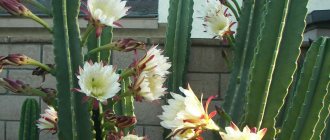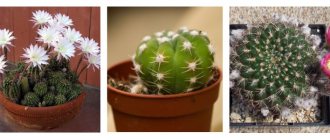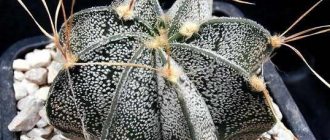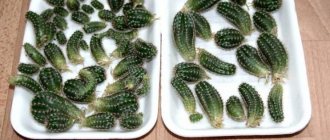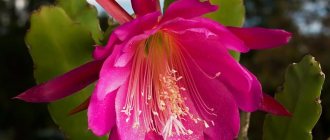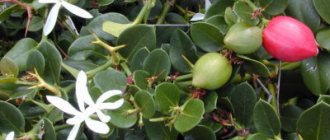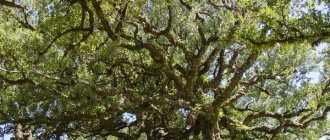- Pereskia: flowering leaf cactus
- Description of the pereska plant
- Types of indoor Persky
- Growing conditions for indoor Peresian
- Lighting and placement
- Temperature and ventilation
- Caring for Pereskaya at home
- Watering and air humidity
- Top dressing and fertilizer composition
- Trimming and shaping pereski
- Transplantation, containers and substrate
- Diseases, pests and problems in growing
- Peresian breeding
- Video: Pereskia - an amazing deciduous cactus
Pereskia: flowering leaf cactus
The status of the most ancient cacti among Peresk is disputed, but they are definitely the most original. Unusual bushes with real leaves and romantic flowering are difficult to mistake for relatives of the usual indoor cacti. Dangerous and beautiful spines only emphasize how extravagant this plant is. Not the most undemanding of conditions, pereskias easily shed their legendary leaves. But they still remain easy-to-grow succulents that can easily add variety to home collections.
Pereskia is a flowering deciduous cactus.
Bloom
Blooms in summer touching early autumn. The main distinguishing feature is that the flowers of this genus of plants lack the typical flower tube for cacti. The flowers are cream-colored, almost always collected in inflorescences. The aroma of flowers is reminiscent of citrus. To flower, Pereskia Godseff requires a large vegetative mass, which is difficult in indoor conditions due to limited growth.
Reference! If the pereskia does not bloom, then it should be transplanted into a larger pot. Feed the plant; to speed up the growth of vegetative mass, you can add hormonal growth preparations (heteroauxin).
Description of the pereska plant
Representatives of the Peresky genus are considered relict and perhaps the most ancient cacti - unusually bright flowering, dangerous spines and graceful leaves. They are allocated to a special subfamily of Pereskieves (Pereskioideae) and are found in nature only in Latin America.
Pereskia are often used as rootstocks for other types of cactus. In Brazil you can enjoy their buds, leaves and a special delicacy - aromatic, unusual, very tasty fruits known as Barbados gooseberries and climbing lemons.
Pereskia, or Peireskia (Pereskia) are distinctive representatives of cacti. These shrubs and trees in nature can reach gigantic sizes and are able to survive in the harshest conditions, storing moisture in the stems. But outwardly they are much closer to herbaceous plants - with deep roots and thin, branched, woody stems. Hidden in the axils of the leaves are beautiful areoles with very large, sharp and hard spines - single or collected in bunches, silver or dark brown.
The true leaves of Peresk are lanceolate-oval, with a pointed tip, reminiscent of laurel leaves. With a length of up to 10 cm, they are shiny, leathery, with different shades of green among species and varieties. They fall off in uncomfortable conditions and during periods of rest, and often fade.
The summer flowering of Pereschi is reminiscent of wild roses and roses thanks to the delicacy of the petals and the lush hemisphere of bright stamens around the very large pistil. Flowers are from 4 cm in diameter, solitary or collected in inflorescences, fragrant, with delicate cream or pink colors.
After flowering, edible, yellowish-reddened fruit cones, up to 2 cm in diameter, begin to develop. Some pereskias can compete with prickly pears in the originality of fruiting, forming entire clusters. After the fruit begins to ripen, the hidden areoles on it begin to swell and grow into new buds or side shoots, as if the fruit is branching at the top.
Pereskia grandiflora.
Features of Pereskia
Pereskia is a leaf cactus. Because of this, its appearance bears little resemblance to the spiny cactus that is most often associated with the word. The color of the leaf blades is purple or green. In the leaf axils, areoles with needles are located in a bunch or singly. Under natural conditions, they help the plant to cling to trees. As the leaf blades age, their color becomes more faded, and they begin to dry out. With the onset of the dormant period, the plant sheds such leaves.
The bush can have a height of about 10 meters, while its annual growth can be more than 20 centimeters. This evergreen leaf cactus has the appearance of a branched shrub and has a massive rhizome. Over the years, lignification of erect shoots is observed, on the surface of which a glossy red-brown bark is formed.
The shoots are decorated with ovoid or oval whole-edged leaf plates, at the top of which there is a point. They can be petiolate or sessile, and their length can reach 50 mm. The foliage folds slightly along the midrib. Its surface is glossy, which protects it from too rapid evaporation of moisture.
Flowering occurs in summer or autumn. A large number of axillary flowers appear on the bush, which do not have a tube, which also distinguishes pereskia from other types of cactus. The flower consists of 8 lanceolate-shaped petals that open wide. Therefore, the flowers of such a cactus are more like rose hips. After pollination, cone-shaped or round berry-like fruits are formed in place of the flowers, which are covered with a glossy beige or yellow skin of high density. These berries should not be eaten. Inside them are several black seeds.
Pereskia Godseff ancient cactus with foliage. Care features
Types of indoor Persky
Pereskia orange (Pereskia bleo) is a plant with oval, large, matte leaves decorated with a wavy edge and flowers reminiscent of red-orange roses, followed by bright cones of inedible fruits.
Pereskia aculeata is a climbing species that forms very dense bushes with large lanceolate leaves and long spines. Rosehip-like, fragrant, wide-open, pale cream flowers with bright orange stamens cover the bush in a scattering. There are many forms and varieties with reddish leaves.
Webber's Pereskia weberiana.
Pereskia aculeata.
Pereskia grandifolia.
grandiflora is prized for its soft pink, large flowers in clusters of inflorescences, highlighted by dark leaves and very long spines.
Webber's Pereskia weberiana is a very beautiful, densely branching species that is easy to form. Small, bright oval leaves and abundant blooms with snow-white flowers seem strikingly romantic.
In Pereskia, the most outlandish fruits can be found in Pereskia grandifolia, with its fruit clusters consisting of ovaries and stems with intricately curved purple flowers.
Benefit
Among the natives of Central and South America, pereskia is considered a medicinal plant. Its leaves and fruits have a rich natural composition. They contain microelements such as:
- ascorbic acid;
- retinol;
- folic acid;
- calcium;
- magnesium;
- phosphorus;
- manganese;
- tryptophan.
Decoctions of fruits and leaves act as a general health-improving, immunomodulatory agent. They help to recover faster from infectious diseases and prevent the spread of viruses. The vitamin complex has a positive effect on the functioning of internal organs, circulatory and musculoskeletal systems.
Stomach and vascular diseases are treated with drinks made from the bark and leaves of the tree. The substances in their composition improve the composition of the blood, thin it, and make blood vessels stronger. Pereskia infusions help eliminate mental disorders and relieve nervous tension. The juice from the leaves of the plant accelerates the healing of skin from wounds and burns. They also treat dermatological diseases, relieve swelling and inflammation.
Growing conditions for indoor Peresian
In order not to be disappointed in this unusual cactus, you should approach the selection of conditions with the utmost care. If you provide your Pereski with access to fresh air, the warmth she loves, and bright lighting, there will be no problems with care.
Lighting and placement
Pereskia are among the most light-loving cacti; they do not welcome artificial lighting and bloom only on sunny windowsills. You can even place them on south-facing windows. Direct summer sun will often burn the leaves, but simply moving them away from the glass or moving them to a spot next to a windowsill in high summer will easily correct this problem. In partial shade, the bushes stretch out and do not bloom.
Maintaining the level of lighting for the winter and moving it to a bright window sill is one of the conditions that allows pereskias not to lose all their leaves.
Temperature and ventilation
Pereskias love fresh air. Drafts are not dangerous (unless there is a sharp jump in temperature and the plant does not bloom). It is necessary to ventilate the premises as often as possible. Whenever possible, it is better to place pereskias in the fresh air, choosing warm places protected from precipitation.
In summer, Pereskias feel great in the warmth. When kept indoors, it is better to maintain a temperature of 21 to 23 degrees. In the fresh air or with constant ventilation, pereskias can withstand any heat.
The ideal temperature for wintering pereski is considered to be about 15 degrees Celsius. The temperature should not drop below 10 degrees. Increasing the indicators to the usual indoor ones requires control of lighting, frequent ventilation and impeccable care.
Orange Pereskia (Pereskia bleo).
Storage and procurement
For medicinal purposes, brightly colored young leaves are collected. This should be done in summer or spring. After collection, the leaves are dried by spreading them on paper or a wooden surface. They should not be exposed to sunlight. Dried raw materials are stored in glass containers for up to two years. The fruits are collected after they ripen. They are consumed fresh or prepared. They can be pickled, dried, dried, stewed. From the fruits of the cactus they make:
- jam
- compotes
- sauces
- salads
- main courses
- alcoholic drinks
Caring for Pereskaya at home
Careful watering, rare fertilizing and attention - these are all the measures that pereskias need to maintain their decorative appearance.
Watering and air humidity
For pereskia, active watering is carried out only during the growth period, but it is better not to completely dry out the substrate even in winter, because during drought, pereskia sheds its leaves. In spring and summer, the soil is allowed to dry in the upper third of the pot, immediately draining the excess from the trays. In winter, watering is reduced. You need to change the humidity gradually.
Despite the dislike of high air humidity, to maintain the decorative appearance of the leaves, it is better to include “refreshing” sprays with warm water in the care of pereskies. The higher the air temperature, the more often they need to be carried out, up to daily in the summer. Dust is removed by washing the leaves; wiping destroys the protective coating.
Top dressing and fertilizer composition
Fertilizers are applied to this cactus only in liquid form and only during the period of active growth. One feeding per month with special fertilizers for succulents and cacti is enough.
Trimming and shaping pereski
Even bonsai can be easily formed from Pereskaya. They tolerate pruning well in spring and summer, provided that at least 1-2 internodes are left on the shoots.
Young pereskias can be replanted several times a year.
Transplantation, containers and substrate
Pereskia requires a very loose substrate with a pH of about 7.0. To the usual soil mixture for cacti and succulents, it is worth adding 40-50% loosening additives that guarantee high air permeability of the soil (coarse sand, perlite, stone chips, gravel).
This cactus is replanted only as needed - as soon as the roots fill the space of the pot. Young cacti can be replanted several times a year; adults often do not need to be “touched” for several years.
For Pereskaya, fairly deep containers are used, corresponding to the unusually powerful root system for cacti. A high drainage layer is required.
Pereskia do not tolerate contact with roots; they are carefully handled. Watering after transplantation should be extremely careful until rapid growth begins.
Diseases and their treatment
Usually the cause of the disease is errors in care (most often waterlogging of the soil). the result of which is the death of the plant. The most dangerous for Peresian: scale insects, spider mites, mealybugs.
As soon as signs of damage become noticeable , the plant should be thoroughly washed under a warm shower (the soil must be protected with plastic wrap from water).
The scale should be removed with a cotton swab soaked in alcohol. In advanced cases, the plant must be treated with chemicals.
Diseases, pests and problems in growing
Pereskia are one of the most sensitive cacti to waterlogging and are extremely susceptible to rot. If there are any signs of damage to the stems, root collar or roots, you must immediately adjust the conditions and care and begin treating with fungicides. An emergency transplant most often leads to death.
Of the pests, all insects that love dry conditions are terrible for the Peresian - spider mites, mealybugs and thrips. It is better to fight them immediately with insecticides.
Fading or dropping leaves, stretching shoots always indicate an excess or lack of light. Growth disturbances most often occur due to irregularities in watering.
At home, pereskia is most often propagated by stem cuttings.
Possible problems
The crop is generally healthy, but can rot if the owners make such mistakes:
- pot too spacious;
- no drainage;
- there are no lower holes in the container;
- dense or overly nutritious substrate;
- overmoistening - owners water without waiting for the top layer to dry in summer, in winter - about a third of the soil volume;
- spraying at temperatures below 20° C or at night.
Infectious diseases are dangerous:
- gray rot;
- mold.
Fungicides are used for eradication. Conditions of detention are normalized.
Pereskia pests:
- mealybug;
- spider mite;
- scale insect
Insecticides are used to control insects. If a tick is found, the preparations must have an acaricidal effect - this pest is an arachnid.
Other problems:
- the brightly colored foliage of Pereskia Godseff has turned green - there is a lack of light;
- the shoots stretch out strongly - it’s dark;
- the flower does not grow - a transplant or more water is needed;
- the wrinkled crown of the shoot indicates overwatering.
Pereskia is a black sheep among desert cacti. You can “suspect” them of being related only thanks to the areolas, which only members of the family have. This is a deciduous plant, unpretentious, with beautiful flowers, revealing its full decorative effect only in good lighting.
Peresian breeding
Growing pereskia from seeds is very difficult due to low germination and extreme sensitivity of seedlings to any increase in humidity. Sowing is carried out to a depth of 1 cm, in very light soil. At temperatures up to 21 degrees, plants are kept in light humidity under a hood. Diving is carried out very carefully in the 4-leaf phase, but it is better to sow directly into individual containers.
At home, pereskia is most often propagated by stem cuttings. You can cut them in spring and summer, using pieces of stems with 1-2 internodes. It is easier to root cuttings in sandy soil under a cover, at a temperature of 25 degrees. When rooting in water, you need to plant the cuttings very carefully, trying not to come into contact with the roots.
Propagation by cuttings and seeds
This cactus is propagated by seeds and cuttings. Both methods are quite effective.
Propagation by seeds:
The seed is soaked in a small amount of water for one day.- Place the soaked seeds in containers with loose soil.
- Sprout in diffused light.
- After the seeds germinate into seedlings, they are transplanted into separate independent pots.
Propagation by cuttings:
- The cuttings are cut in the summer with sharp sterile pruning shears.
- Select cuttings without wood, but already strong.
- Place the cutting in a container with water, treating the cut with growth hormones.
- After the first roots appear, rooting is carried out in a pot with loose soil.
- The pot is covered with perforated film and placed in a warm, bright place.
- After growth, the top of the young plant is pinched.
We invite you to watch a video about cuttings from Pereskia Godseff:
Growing pereskia from seeds
Pereskia fruit and seeds photo
Go to a flower shop for seeds. Plan sowing for spring.
- You need to prepare wide containers (regular or seedling box, plastic container) with a sand-peat mixture.
- Level the surface of the soil and spray with a fine spray, plant the seeds to a depth of 1-1.5 cm.
- You will need to cover the crops with a transparent bag or glass to create a greenhouse effect, place them under diffuse lighting and maintain the temperature in the range of 20-22 °C.
- Raise the shelter every day for ventilation, spray the surface of the soil as it dries.
- Under such conditions, seedlings will begin to appear in 2-3 weeks. After which the shelter is removed, and other conditions remain the same.
- At the stage of appearance of 3-4 leaves, transfer the seedlings into separate containers, trying to pry up the roots of the plant along with the earthen lump and carefully transfer it.
General information
Tree-like specimens are also found. They have powerful, smooth stems that become covered with bark over time.
The leaves have an oval shape. As they grow at the bottom of the stem, they fall off, leaving a bare trunk with long, hard spines.
The plant blooms with yellow-white flowers that bloom in late summer and have a pleasant aroma.
After flowering, round, yellow, edible fruits are formed in their place, which is why the plant has another name: “Surinamese gooseberry”
